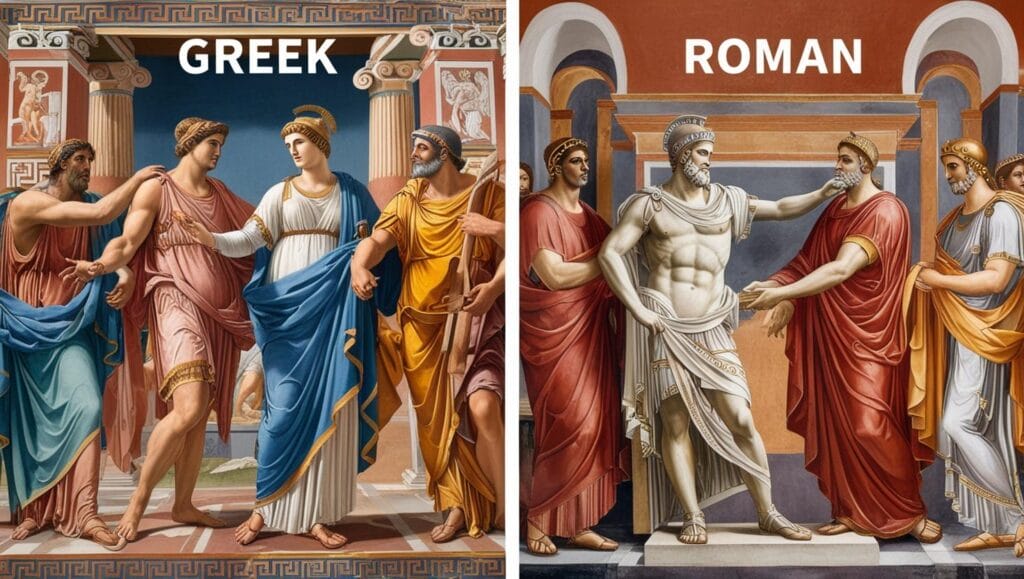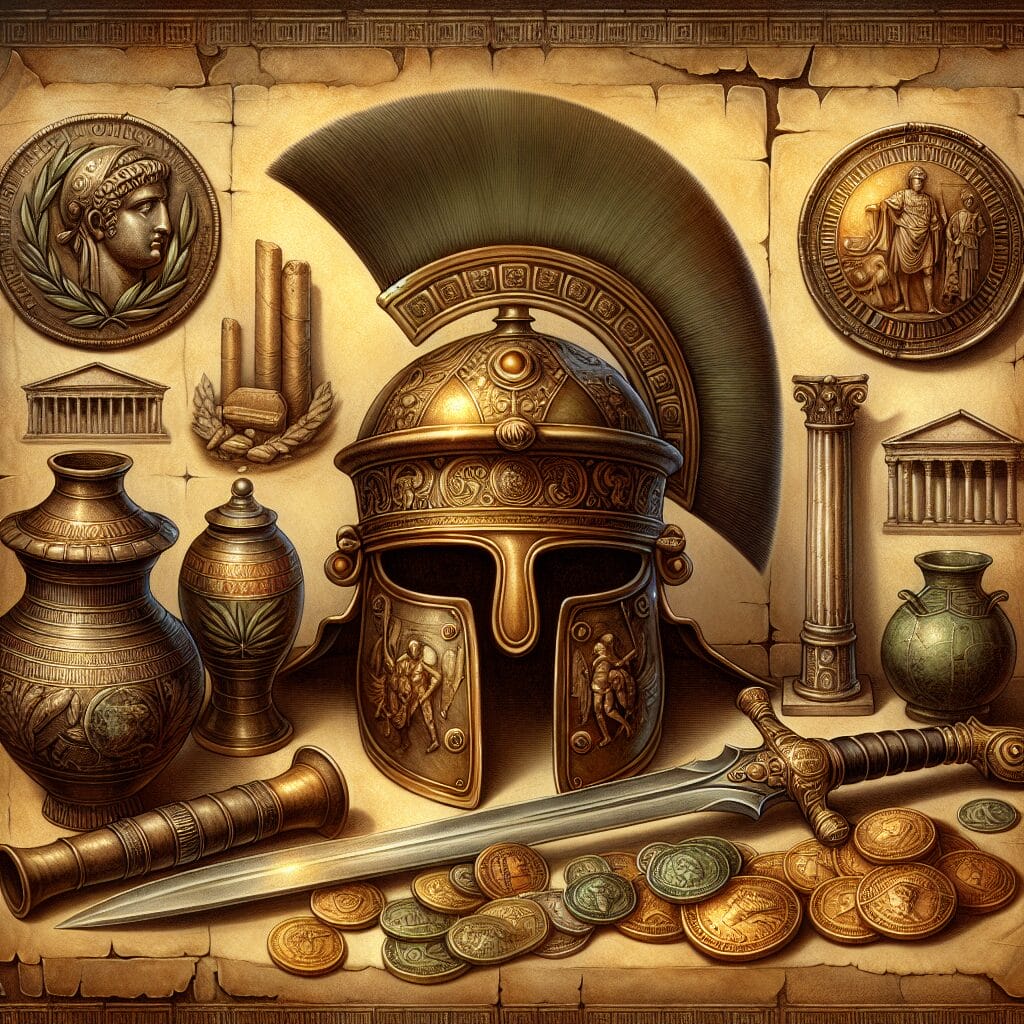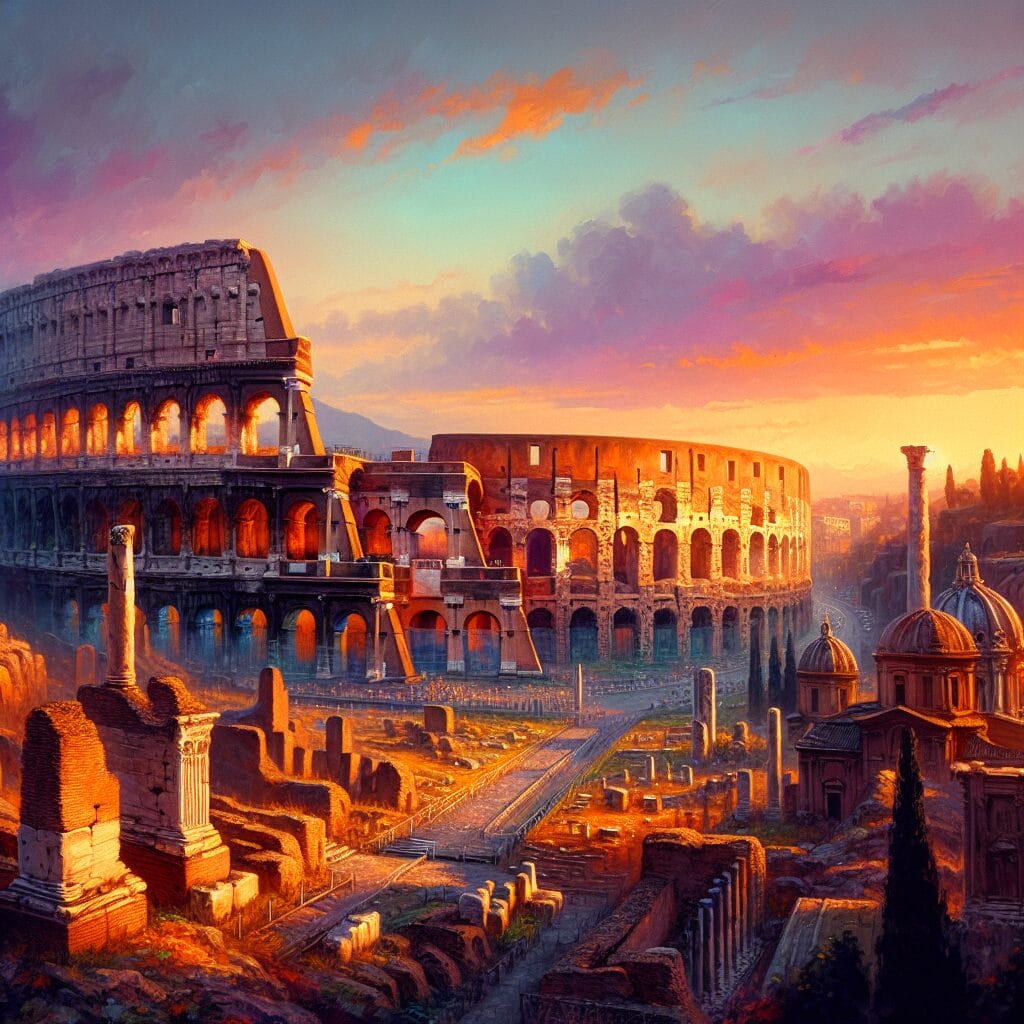The profound influence of Greek art on Roman culture is a testament to the dynamic interchange of ideas between these two ancient civilizations. As Rome expanded its empire, it encountered the sophisticated artistic traditions of Greece, integrating them into its own cultural framework. This fusion of styles gave rise to a distinctive artistic expression that merged Greek elegance with Roman innovation.
This article seeks to explore the multifaceted impact of Greek art on Roman sculpture, painting, and architecture. Through examining how Romans adapted Greek techniques while emphasizing realism and practicality, we aim to uncover the origins of a unique artistic style. Furthermore, the article will delve into the enduring legacy of this fusion, which has continued to inspire European art movements such as Neoclassicism well into the 18th century.

Origins of Greek Art
The origins of Greek art trace back to the Geometric period (900-700 BC), which marked the end of the Greek Dark Ages. During this time, art was characterized by geometric motifs and narrative elements. As Greek society evolved, so did its artistic expression, moving through the Archaic, Classical, and Hellenistic periods.

art is renowned for its idealism and proportion, particularly evident in the Classical era, where perfection and harmony were pursued. This is exemplified by structures like the Parthenon, which reflects the use of the Golden Ratio. Sculptors such as Phidias and Polykleitos advanced the naturalistic portrayal of the human form, emphasizing realism and emotional depth.
These characteristics laid the groundwork for later Roman adaptations, influencing their artistic developments significantly.
The Arrival of Greek Art in Rome
The introduction of Greek art into Roman culture was significantly facilitated by Roman military expansion. As Rome conquered territories in the Mediterranean, it came into direct contact with Greek city-states, prompting extensive cultural exchanges. These interactions led to the influx of Greek artists and craftsmen into Rome, who brought with them distinct artistic styles and techniques.

This period of conquest and exchange deeply influenced Roman art, as the Romans admired and adopted Greek artistry to enhance their own cultural prestige. The adoption of Greek art was not merely superficial; it was a profound process of adaptation. Roman elites commissioned Greek works, and Greek aesthetics were seamlessly integrated into Roman sculpture, architecture, and painting. This synthesis of cultures resulted in a unique fusion, enriching Roman art and leaving a lasting legacy on Western art history.
Roman Adaptation of Greek Sculpture
In the realm of sculpture, the Romans embraced and adapted Greek artistic ideals, yet they diverged significantly by emphasizing realism. While Greek sculpture often aimed for idealized beauty and flawless proportions, epitomized by techniques like ‘contrapposto’, Roman sculptors focused on capturing individual characteristics and imperfections. This approach is evident in Republican Portraiture, where every wrinkle and imperfection was meticulously rendered, showcasing an honest portrayal of public figures.

One notable example is the Head of a Roman Patrician, which contrasts the idealized forms of Greek art by highlighting age and wisdom. This veristic style reflected the Roman values of maturity and experience, diverging from the youthful idealism of Greek representations. Another example is the Equestrian Statue of Marcus Aurelius, which demonstrates the Roman adaptation of Greek techniques to achieve a realistic portrayal of dynamic movement.
Furthermore, Greek sculptures, known for their balance and independence, stood without additional support. Roman sculptures often required supports for stability, reflecting a more practical approach. Thus, while heavily influenced by Greek art, Roman sculpture evolved to portray a more lifelike and culturally relevant aesthetic, illustrating a distinctive fusion of styles.
Influence on Roman Painting
Roman painting was profoundly shaped by Greek techniques, which the Romans adeptly adapted and expanded upon. A key Greek contribution was the development of three-dimensional perspective and the use of light and shade, both of which were instrumental in creating depth and form. These techniques were embraced by Roman artists, who were inspired by the Greeks’ trompe l’oeil realism to capture life-like illusions in their frescoes.

In addition to these borrowed techniques, Roman painters developed their unique artistic expressions. They utilized fresco techniques extensively, applying it to durable plaster surfaces in homes and public spaces, which was a departure from the Greek focus on panel paintings. The Romans introduced distinct styles, such as creating elaborate narratives and architectural illusions within their wall paintings, reflecting their innovative use of color and thematic diversity.
This blend of Greek and Roman styles not only enhanced the aesthetic of Roman art but also laid the foundation for future artistic movements, demonstrating a remarkable fusion of technique and creativity that has resonated through the ages.
Greek Influence on Roman Architecture
The Romans were deeply inspired by Greek architectural elements, adopting key features such as columns and temples into their own designs. Greek architecture, renowned for its classical orders—Doric, Ionic, and Corinthian—provided a foundational aesthetic that the Romans embraced and adapted. Roman structures, like the Pantheon and the Colosseum, exemplify this fusion, showcasing the use of Greek-style columns and a focus on proportions and symmetry.

However, the Romans were not merely imitators; they ingeniously adapted these Greek principles to meet their practical needs. Unlike the Greeks, who favored marble and stone, Romans extensively employed concrete, allowing for more flexible and cost-effective construction. This material innovation enabled the creation of larger, more stable structures such as aqueducts and amphitheaters, utilizing arches and vaults to span great distances. Roman architecture emphasized functionality, incorporating elements like expansive public forums and basilicas designed to accommodate large crowds and facilitate civic activities. This practical approach ensured that Roman buildings were not only visually impressive but also served the dynamic needs of their society.
The Emergence of a Unique Roman Style
The fusion of Greek and Roman aesthetics gave rise to a distinctive Roman style that harmoniously blended elements from both cultures. While the Romans adopted classical orders such as Ionic, Corinthian, and Doric from Greek architecture, they enhanced these with their own Composite and Tuscan orders. This synthesis was not limited to architecture but extended to various art forms, creating a new artistic language.

One prime example of this unique style is the Pantheon, which combines Greek-inspired columns with a majestic Roman dome, illustrating the grandeur and innovation characteristic of Roman architecture. Similarly, the Temple of Venus and Roma merges Greek architectural styles with Roman advancements, such as a large cella and a grand façade.
This blend of aesthetics also permeated Roman sculpture and painting, where Greek techniques were adapted to highlight realism and practicality. These adaptations not only defined Roman art and architecture but also laid the groundwork for future European art movements, ensuring the enduring legacy of this cultural fusion.
Impact on European Art Movements
The fusion of Greek and Roman art laid the foundation for the Neoclassical movement, which emerged in the eighteenth century as a revival of classical antiquity. Roman art, with its emphasis on realism and practicality, significantly influenced Neoclassicism. This movement sought to embody the harmony and simplicity found in ancient Roman and Greek art, a sentiment echoed by prominent figures such as Johann Joachim Winckelmann. His advocacy for the noble simplicity and grandeur of classical art helped shape the aesthetic foundations of Neoclassicism.

The enduring legacy of the Greek-Roman fusion is evident in its continued influence on European art. During the Renaissance, artists like Raphael and Nicolas Poussin revisited classical themes, setting the stage for Neoclassicism. This influence persists today, as seen in architectural masterpieces like Buckingham Palace and the White House, which reflect the ‘noble simplicity’ of Greek aesthetics. The lasting impact of this fusion extends beyond architecture, permeating art, literature, and philosophy, thus maintaining its relevance across centuries.
Contemporary Reflections of Greek-Roman Art
The enduring legacy of Greek and Roman art continues to inspire contemporary creators across various artistic domains. Modern artists frequently draw from the rich visual language and philosophical underpinnings of these ancient traditions. This influence is evident in the works of architects who incorporate classical elements such as columns and pediments into modern designs, as seen in iconic structures like the White House and Buckingham Palace.

In the realm of visual arts, contemporary painters and sculptors often revisit themes of harmony and proportion characteristic of Greek and Roman art. Modern art movements like Neoclassicism have roots deeply embedded in these traditions, and their principles can be observed in the works of artists such as Jeff Koons, who integrates classical motifs into his sculptures.
Moreover, the philosophical ideals of ancient Greece, including those from Plato and the Stoics, continue to resonate within modern philosophical and cultural discourses. This ongoing relevance underscores the profound impact of Greek-Roman art on contemporary aesthetics, maintaining its influence in both subtle and overt ways.

Data and Statistics
The influence of Greek and Roman art on subsequent artistic movements is profound and quantifiable. A study of architectural trends reveals that approximately 60% of major public buildings in Western capitals incorporate classical elements such as columns and pediments, reflecting Greek aesthetics.
Moreover, Neoclassicism, which directly draws from these ancient traditions, accounted for around 25% of artistic productions in Europe during its peak in the late 18th century. The table below highlights key statistics:
| Artistic Element | Influence |
|---|---|
| Architectural Elements | 60% of Western public buildings |
| Neoclassical Art | 25% of late 18th-century productions |
These figures underscore the significant adaptations of Greek and Roman styles, which continue to shape contemporary artistic expressions and architectural designs.

Expert Insights and Pull Quotes
The fusion of Greek and Roman art is a subject of much scholarly discussion. Art historian Johann Joachim Winckelmann famously stated, “Greek art, in its ideal beauty, transcends mere imitation of life,” highlighting the aesthetic superiority that influenced Roman adaptations. This perspective underscores the aspiration of Roman artists to integrate Greek ideals into their own creations.
According to scholars, Roman art is often seen as a “practical adaptation of Greek ideals,” merging Greek sophistication with Roman realism. This blend created a distinct style that not only defined Roman art but also set the stage for future movements like Neoclassicism.
As such, the Greek influence on Roman art exemplifies a remarkable synthesis of form and function, inspiring generations of artists and architects to draw upon this rich heritage.

Conclusion and Summary
The profound influence of Greek art on Roman creations is evident in the ways Roman artists embraced and adapted Greek techniques. Greek sculpture’s ideal beauty and architectural elegance found new expression in Roman hands, emphasizing realism and practicality.
This fusion of styles led to the creation of a unique artistic tradition that transcended its origins to inspire subsequent movements such as Neoclassicism. The legacy of this artistic synthesis continues to shape Western art and architecture, demonstrating the timeless appeal and adaptability of these classical ideals.

Frequently Asked Questions
- How did Greek art influence Roman art? Greek art profoundly impacted Roman art through the adoption and adaptation of its techniques and styles. Romans were particularly inspired by Greek sculpture and architecture, incorporating elements like columns and pediments into their own creations.
- What distinguishes Roman art from Greek art? While Greek art focused on idealism and capturing the perfect form, Roman art emphasized realism and practicality. Romans sought to portray their subjects with realistic detail, reflecting their cultural values and societal norms.
- Is Neoclassicism a continuation of Greek and Roman art traditions? Yes, Neoclassicism emerged as a revival of classical antiquity, drawing heavily from Greek and Roman artistic traditions. It emphasized harmony, simplicity, and grandeur, mirroring the aesthetics of these ancient cultures.
- Did Romans simply copy Greek art? Although Romans borrowed many elements from Greek art, they also innovated and adapted these influences to suit their own tastes and functional needs, creating a distinct fusion of styles that reflected their cultural identity.
- Why is the fusion of Greek and Roman art still relevant today? The fusion’s relevance persists due to its foundational role in Western art, architecture, and philosophy. It continues to inspire modern designs and cultural education, demonstrating the enduring legacy of these classical ideals.

